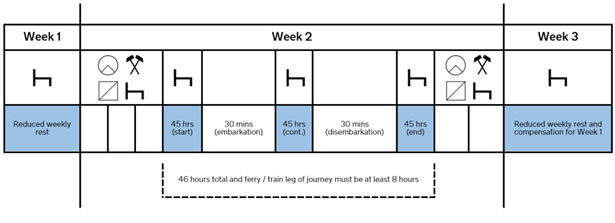
Journeys involving Ferries or Trains
Here a driver accompanies a vehicle that is being transported on ferries or trains, the daily and weekly rest requirements are more flexible.
Interrupting regular daily rest periods
A regular daily rest period may be interrupted no more than twice, but the total interruption must not exceed 1 hour in total. This allows a vehicle to be driven onto a ferry or train and off again at the end of the crossing, including customs formalities.
A regular daily rest
A regular daily rest is a period of rest of at least 11 hours’ duration or 12 hours if split into two periods of rest of at least three hours duration followed by at least 9 hours duration
Where the regular daily rest period is interrupted in this way, the total accumulated daily rest period must still be at least 11 hours or 12 hours if split.
For example, a qualifying regular daily rest period could be interrupted in the following manner:

For example, a split daily rest could be interrupted in the following manner.

It is also permitted to have one of the interruption periods falling in the 3-hour part of a split rest period and one interruption period falling in the 9-hour part of a split rest period or for both parts of the interruption period to fall within the 3-hour part of the split daily rest.
Any regular daily rest period that is interrupted must be completed within the 24-hour period (if single manned). The 24-hour period commences at the point of starting duty following the end of the previous rest period, whether that previous rest period is a daily or a weekly rest period, as shown in this diagram:

Interrupting weekly rest periods
Note: Under AETR rules, it is currently only permitted to interrupt regular daily rest periods and not weekly rest periods.
EU weekly rest periods may be interrupted no more than twice, but the total interruption must not exceed 1 hour in total but when interrupting a regular weekly rest period, the ferry or train leg must be at least 8 hours duration. The interruptions allow a vehicle to be driven onto a ferry or train and off again at the end of the crossing and includes customs formalities.
When an EU reduced weekly rest period is interrupted, the total accumulated weekly rest period must still be at of least 24 hours duration. The weekly rest period must have commenced no later than 6 X 24 hours periods, calculated from the end of the previous weekly rest period.
A sleeper cabin, bunk or couchette must be available during the EU reduced weekly rest period.
A reduced weekly rest
A reduced weekly rest is a rest period of at least 24 but less than 45 hours’ duration. It must be compensated for by an equivalent period of rest taken in one block before the end of the third week following the week in question. The compensating rest must be attached to a period of rest of at least 9 hours – so either a weekly or a daily rest period.
This is an example of interruptions to an EU reduced weekly rest period:

When an EU regular weekly rest period is interrupted, the total accumulated weekly rest period must still be of at least 45 hours duration. The weekly rest period must have commenced no later than 6 X 24 hours periods, calculated from the end of the previous weekly rest period.
Interrupting an EU regular weekly rest is only permitted where the ferry or train leg of the journey is scheduled for 8 hours or more and the driver has access to a sleeper cabin.
A regular weekly rest
A regular weekly rest is a period of rest of at least 45 hours’ duration.
This is an example of interruptions to an EU regular weekly rest period:

Multi-manned journeys involving a ferry or train
Drivers who are engaged on multi-manning can also interrupt a regular daily rest period or weekly rest periods as detailed above. It should be noted however that when interrupting a daily rest period in a 30-hour spreadover, the daily rest period must be a regular daily rest of at least 11 hours or 12 hours, if split. The interrupted rest must be completed within the 30-hour spreadover.
Travelling Time
Drivers of passenger-carrying vehicles are often required to be relocated to a vehicle they are required to drive or from a vehicle, they have driven.
Where a vehicle coming within the scope of the EU rules is neither at the driver’s home nor at the employer’s operational centre where the driver is normally based, but is at a separate location, time spent travelling to or from that location to take charge of the vehicle, regardless of the mode of transport, cannot be counted as a rest or break, unless the driver is on a ferry or train and has access to a sleeper cabin (if interrupting a regular weekly rest period), or a sleeper cabin, bunk or couchette (if interrupting a regular daily rest period or a reduced weekly rest period).
Even if the driver is not paid or makes the decision himself or herself, to travel to or from home/base the travel time cannot be counted as rest or break.
For example: If a coach driver had to travel for 1 hour by car, on public transport or as a passenger, to pick up a coach from a location that was not their home or normal operating base then this time would count as other work. Similarly, if they had to travel back by car, on public transport or as a passenger, from a location that was not their normal operating base, this would count as other work.

A driver who has driven a vehicle in scope of EU rules and has completed their maximum driving time (9 or 10 hours) may be driven back to base or home (e.g. by travelling in a car or as a passenger on a coach), provided they are not required to start a daily rest period or a weekly rest period before reaching base or home. They should record this activity as other work or availability, depending on whether they undertake additional work, such as navigating, while a passenger.

Source – DVSA
Contact us to find out more